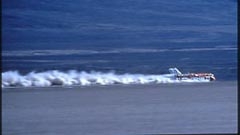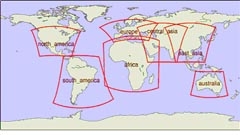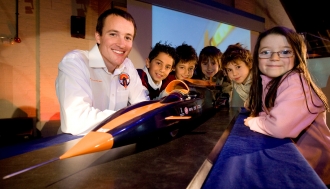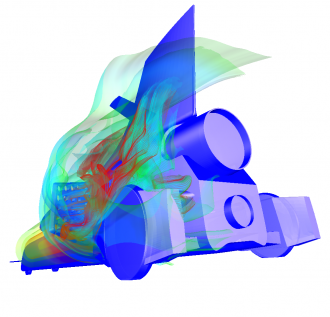Why Search for a New Desert?
 Desert selection has been taken as a relatively simple process in the past, with few exceptions. The legendary British record-breaker Sir Malcolm Campbell was the first person to set a World Land Speed Record at Bonneville Salt Flats, Utah, in 1935, becoming the first man to drive at over 300 mph in the process. This enormous expanse of flat, hard white salt was perfect for record breaking and for almost 50 years after Campbell’s famous visit, it was the only place to do it. However, in 1982, Richard Noble arrived at Bonneville at the very end of the season to continue his battle on the salt with a metal-wheeled jet car, which did not seem particularly to like the very hard salt surface. Perhaps fortuitously, Richard and his team were rained off virtually as they arrived, forcing them to look for other locations in the US – and hence the Black Rock Desert’s record-breaking potential was discovered.
Desert selection has been taken as a relatively simple process in the past, with few exceptions. The legendary British record-breaker Sir Malcolm Campbell was the first person to set a World Land Speed Record at Bonneville Salt Flats, Utah, in 1935, becoming the first man to drive at over 300 mph in the process. This enormous expanse of flat, hard white salt was perfect for record breaking and for almost 50 years after Campbell’s famous visit, it was the only place to do it. However, in 1982, Richard Noble arrived at Bonneville at the very end of the season to continue his battle on the salt with a metal-wheeled jet car, which did not seem particularly to like the very hard salt surface. Perhaps fortuitously, Richard and his team were rained off virtually as they arrived, forcing them to look for other locations in the US – and hence the Black Rock Desert’s record-breaking potential was discovered.
Unlike salt, the Black Rock Desert is an alkali playa surface. Put simply, it is a fine dry mud surface, very smooth and firm but nowhere near as iron-hard as the salt of Bonneville. The more compliant alkali playa surface proved to be far better suited to the solid metal wheels that Richard’s Thrust 2 employed. In 1983 Richard Noble returned to the Black Rock Desert and, driving Thrust 2, achieved a new World Land Speed Record of 633 mph. It was then a natural follow-on for Richard and his team to return to Black Rock in 1997 with the new car, Thrust SSC, which also took to the alkali playa surface extremely well. In its single visit to the Black Rock Desert, Thrust SSC set 2 new records, the latter of which was the first (and currently only) supersonic Land Speed Record at an average speed of 763 mph.
In light of this impressive record, surely BLOODHOUND will return to the Black Rock Desert? Sadly, no. A lack of rain over the last decade, together with increasingly heavy use for the playa surface (principly by the annual Burning Man festival) has left the Black Rock surface in poor condition. It is bumpy, crumbly, rutted and uneven for much of its 140+ square mile surface and is not currently a suitable surface on which to run a car like BLOODHOUND. Hence an alternative surface is required – and we need to find one, wherever in the world it may be.
In addition, BLOODHOUND is likely to require 2 or 3 seasons of runs to develop its potential up to 1000 mph. Having to wait for a once-a-year dry season at a single venue (or even in a single country) could slow the project down considerably. Hence we also want to find somewhere, maybe even alternative venues, in other parts of the world, which are available at different times of the year.
The first choice is between salt and alkali. Our major concern is that no team has ever run a solid-wheeled jet car successfully on a salt surface. That’s not to say that it can’t be done, it just hasn’t been done so far, so we are treating the problem with a degree a caution and would choose an alkali playa in preference. Question is, where can we find one?
The Desert Search Plan
 The plan was to complete a search of the whole globe in 4 phases:
The plan was to complete a search of the whole globe in 4 phases:
Phase 1 – Global search for perfectly flat areas, with no vegetation, in excess of 10 miles long.
This phase was carried out with the invaluable help of Dr Adrian Luckman of the School of Environment and Society at Swansea University. Adrian wrote a brilliant programme that would let us search the whole world for possible sites (link to Phase 1 page). Unfortunately, that produced several thousand possibilities, leaving us to spend a very long day with Google Maps identifying likely candidates. This yielded a list of 35 potential sites.
Phase 2 – Search for additional information on Phase 1 candidates.
Again thanks to the terrific support of Swansea and Adrian Luckman, we added Landsat imagery from the space shuttle together with basic weather data. This got us down to a list of 22 possibles.
Phase 3A – Additional requirements (access, security, local infrastructure, etc.) as listed above.
This reduced the list still further to 14 sites: 8 in the US, 1 in Turkey, 1 in South Africa and 4 in Australia. We also had another 2 in reserve, in India and Bolivia (both of which have access and security difficulties), if we don’t find enough sites in the top 14.
Phase 3B – Site visits
Once we’re down to the final list, this is really the only way to find what we are looking for.
Swansea University

Swansea University is proud to be part of the BLOODHOUND team. Our work on computer fluid dynamics (CFD) is at the heart of research on the design and aerodynamics of the 1,000mph Car.
Swansea University is a world-class research-led dual campus university. Its main base, Singleton Park Campus, is located on a beautiful 47 acre parkland estate and its £450 million Bay Campus, which opened to students in September 2015, is based on the beach on the eastern side of Swansea city centre.
The University was established in 1920 and currently offers around 350 undergraduate courses and 100 post-graduate courses to over 19,000 undergraduate and postgraduate students.
 Ben Evans showcases a model of the BLOODHOUND SSC to school children at the launch in 2008 at the National Waterfront Museum
Ben Evans showcases a model of the BLOODHOUND SSC to school children at the launch in 2008 at the National Waterfront Museum
Swansea University continues to maintain its position as one of the top universities in the UK for engineering. The College of Engineering is now based at Swansea University’s Bay Campus , which has four buildings dedicated to engineering, holding 30,000m2 of laboratory and office space and over £10 million of new research and teaching equipment.
The College of Engineering is ranked within the Top 10* in the UK and is internationally recognised for its cutting-edge research with 94% of research produced by academic staff rated World-Leading or Internationally Excellent quality** .

The College has strong and establish links with a large variety of local, national and international companies both with its teaching and research. It has significantly contributed to a number of prestigious projects from the aerodynamics design of the THRUST Supersonic Car, which currently holds the World Land Speed Record, to BLOODHOUND.
The computer fluid dynamics (CFD) research for BLOODHOUND is being undertaken at the Zienkiewicz Centre for Computational Engineering (ZCCE) one of four research centres with the College.
To find out more about the College of Engineering please go to our website www.swansea.ac.uk/engineering or follow us on Facebook, Twitter or Instagram .
* The Times & Sunday Times University Guide 2016
** Research Excellent Framework 2014

